|
Click pictures for a larger version.

Author trains at Gunsite
Academy.
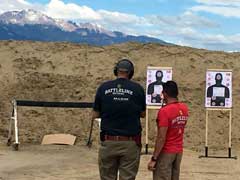
Author trains with Battleline
Tactical at Pike's
Peak Gun Club.
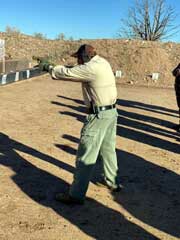
Gunsite instructor Chris Currie.
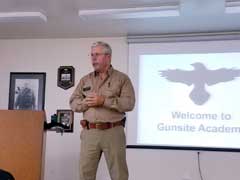
Gunsite instructor Ed Head in the classroom.
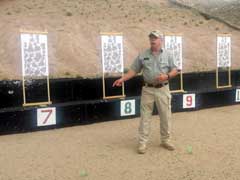
Gunsite instructor Ed Head on the range.
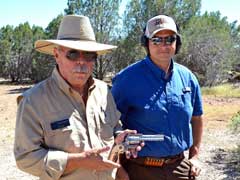
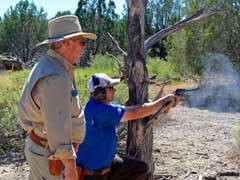
Ed Head and Bobby Tyler, with Ed's engraved Ruger
Bisley by Tyler Gun
Works.
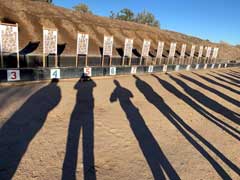
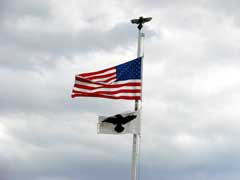
|
|
So,
youíve taken one of the best self-defense decisions you can
and decided to get some formal training.
Now what? Where
to start? There are so many options to choose from.
Let me walk you through how I did it, not so long ago.
First,
and foremost, decide on how much time you can devote to your
training...can you only spare one day?
A weekend? Or an entire week?
This will help dictate what training you should look for.
If you can only afford to take one day out of your
schedule, you may need to stay local and look for training in
your area. A
weekend? Maybe you
can make it a little farther...perhaps up to 5-6 hours away from
home so you can get there after work on Friday, still get a good
nightís sleep and train the weekend before heading home on
Sunday evening. Dedicating
a full week takes more planning, but gives you more options as
you now have a weekend before and after to get there and back.
Ok,
you know how much time you have.
Start doing some research.
Decide what type of training you are looking
for...self-defense? Close quarters?
Vehicle? Security
(places of worship, sanctuaries, etc), long range rifle?
Sporting rifles? Shotgunning?
The options are almost endless.
The internet is equally endless and will get you started
on what are options for your training needs and desires.
Check out your local ranges; many offer routine training,
some offer ad hoc classes where they bring in a trainer.
There are trainers that tour the country to teach and use
different local ranges all over.
Also donít forget to research recommendations from past
students, this will give you a good feel for what to expect, not
only with course content, but instructor qualifications and
expertise, facilities, usefulness of the training, amenities,
etc...
Once
you find one that fits your schedule and travel constraints,
donít forget to look at your budget!
By
budget, donít just look at the cost of the training, but look
at transportation (airline, rental car, gas), hotel, and food.
Make sure you have all of that planned and factored in.
Donít forget to look at the curriculum and make sure
that you also budget accordingly for ammunition costs
(some courses will have you shoot 1000+ rounds, which
adds up), and donít forget the gear you may not have...knee or
elbow pads, flashlight, etc...
Having
gone through that process a few times, I decided that I needed
some formal self-defense training and that a weeklong course
would suit my schedule and needs.
Looking at available options, I settled on the
grand-daddy of them all, and booked a basic pistol self-defense
class at Gunsite Academy in
Paulden, Arizona. This
course, named the 250 class, would hopefully provide me with
some good, solid, fundamentals.
Gunsite, founded by the late Colonel
Jeff Cooper in 1976, is the premier gun-fighting school in
the world. Teaching
not only marksmanship, but also gun-handling and The
Combat Mindset, and with around 3,000 acres, over twenty
different ranges, around fifty instructors, both men and women,
who have a background of military, law enforcement, or have a
high degree and experience of training in their field, the
training experience offered is almost unlimited. From basic
pistol square range, to indoor and outdoor simulators, long
range rifle, and force-on-force, there isnít much that you
canít train on there, and it makes for a perfect venue to test
and evaluate weapons.
I
eagerly booked my class, hotel room for the week, found a good
flight and rental car, and impatiently waited.
During
the wait, I went through endless permutations of what gear I
should take. Being
founded by Jeff Cooper, there is a strong penchant for the 1911
pistol at Gunsite, but my research told me that any handgun of
acceptable caliber would be adequate. There was no need to buy a new pistol (darn, I was looking
for a good excuse to buy another gun!).
If you arenít sure of what pistol to take, or if you
live in a more restrictive locality where handgun possession is
difficult, ask your training facility if they rent pistols.
Many do, and that can be a viable option.
Already having a few 1911 pistols in my collection, I
decided to use my Ruger SR1911 in 45 ACP.
Once
youíve settled on a handgun, make sure you have an adequate
holster. Most facilities, instructors, and gun people will insist on a
sturdy holster made of either leather or some sort of hard
polymer, like Kydex, that will provide not only a secure and
sturdy means to carry your handgun but will also ensure ease of
re-holstering it once finished using your handgun.
Being more of a traditionalist, I knew I wanted a leather
holster. I contacted my good friend Rob Leahy at Simply
Rugged Holsters, who set me up with one of his wonderful
leather Holsters, the Cuda, which is designed for both concealed
carry and range use. With
the holster, I also purchased three single magazine pouches, so
I could carry my spare magazines on my belt.
Spare
magazines...wait a second, how many would I need and did I have
enough? A quick check with Gunsite confirmed that it would be best to
have at least 6 magazines...one for in the gun, 2-3 for on my
person, and a few spares, as magazines tend to hit the gravely
and dusty Arizona deck during reloads and can get damaged.
Ok, I had enough spares, but what else did I need?
Sturdy
belt, check. Hat,
check. Safety
glasses, check. Hearing
protection, check (I strongly recommend electronic hearing
protection as these help hear instructions and basic
communications, but good old ear plugs work just fine too).
The Gunsite 250 class does have some teaching of
different shooting positions such as prone and kneeling, so I
opted to bring some knee pads, just to be safe (and I wasnít
sorry), which I found used at a local Army surplus store.
Is there some night time shooting?
Flashlight, check.
I
also made sure I had lip balm, sun screen, and a pair of
comfortable shoes. On the topic of shoes, make sure you bring a pair of shoes
that you will be comfortable in being on your feet for 8+ hours
a day. You donít
necessarily need combat boots, but a good pair of hiking shoes
that have been broken in will make the experience much more
comfortable. Your
training class is not the right time to break in your new hiking
boots! One item I
didnít think of ahead of time, but went and bought during my
class, was athletic tape. I
didnít adequately anticipate the rubbing, chafing and blisters
on my hand from shooting all those rounds and found that a few
pieces of strategically placed surgical tape helped protect my
hands and fingers. Trust
me, your nicely checkered front strap can feel like a cheese
grater after only a few hundred rounds over a few days.
I now keep a roll or two of tape in my range bag all the
time.
Itís
also not a bad idea to have a cleaning kit with you, just in
case. Even if itís just a basic kit with some rags, bore brush
or bore snake, your favorite lubricant, etc.
It can sure come in handy!
Some
training facilities will have ammunition for sale there, others
will require you to bring your own.
Make sure you find out before you get there and make the
necessary preparations. Shipping
ammunition to yourself ahead of time can get expensive but is an
option; so is stopping at a sporting goods store on your way
there, but Iíd strongly recommend you donít wait until the
last minute to roll in to the only place in town, 5 minutes
before close on the day before the class and risk finding out
that they were cleaned out of your caliber ammunition by other
students also waiting for the last minute and beat you to it.
Donít
forget medication, emergency contact information, range
necessities such as snacks and water (hydration is critical!).
A small range bag helps carry your gear easily, along
with some ammo. You
donít need anything fancy, but something sturdy enough.
Once
you have all of your gear (did you make your list and check it
twice?), make sure you get some good rest before and during your
class. You need to
be fresh and alert, not only to maximize your training and
learning but, most importantly, to be safe to yourself, other
students, and the instructors there with your gun handling.
This is much more easily done when you are well rested
and alert.
Now
itís time to train! Get
to your class on time, be safe, and donít be afraid to ask
questions; thatís why the instructors are there.
Maximize your training opportunity by taking advantage of
repetitions (for example, if one relay isnít full, ask the
instructor if you can jump in and shoot again!). The old clichť of practice makes perfect applies here.
Enjoy your training, have fun and learn how to be better.
Remember,
proper preparation prevents poor performance!
Well,
youíve read my thoughts, from personal experiences, now get
trained and let me know what you have learned from your own
experiences on how to better get ready for the next training.
See
you on the range!
Matt
Olivier
  
Got something to say about this article?
Want to agree (or disagree) with it? Click the following link to
go to the GUNBlast Feedback Page.
|
|
Click pictures for a larger version.
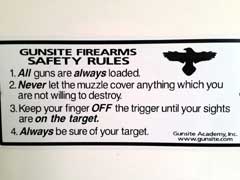
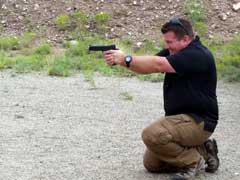
Mike McNett of Double
Tap Ammo tests
loads at Gunsite.
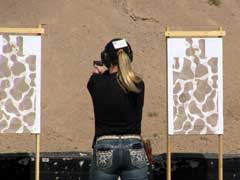
Elise Bennett shoots the 250 Course at Gunsite.

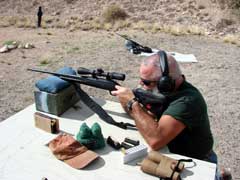
Jeff Quinn at Gunsite.
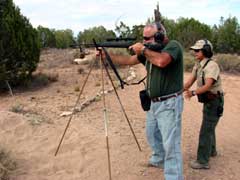
Jeff Quinn at Gunsite with instructor Il Ling Nu.
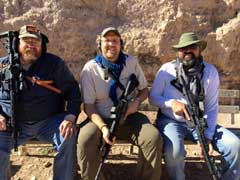
Some dear friends (L-R): Rob Leahy of Simply
Rugged Holsters, author Matt Olivier, and Scott Tschirhart.
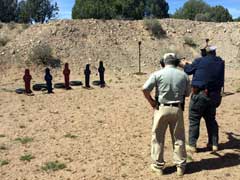
Ed Head with Rob Leahy at Gunsite.
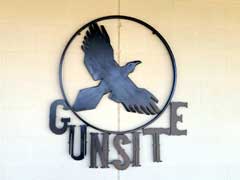

|
![]()